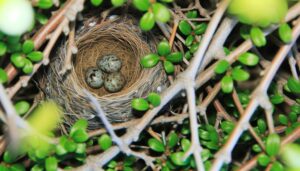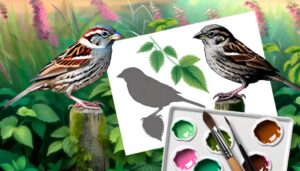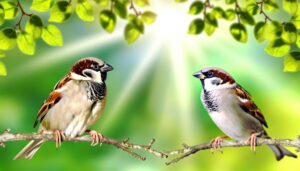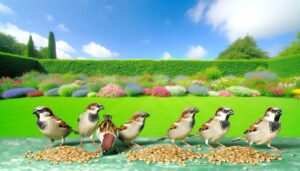Feed House Sparrows in 3 Simple Steps
Feeding a house sparrow necessitates a balanced and varied diet focusing on seeds, grains, and small insects. Millet, cracked corn, and sunflower seeds are ideal due to their size and nutrient content.
Include protein-rich sources like insects, mealworms, and boiled eggs, especially during breeding seasons. Avoid harmful foods such as bread, chocolate, avocado, onions, and garlic to prevent toxicity.
Maintain cleanliness by regularly disinfecting feeders and replacing food daily to prevent mold. Adjust dietary offerings seasonally, providing high-energy foods in winter and protein-rich options in summer.
Observing their health and feeding habits can reveal much about their well-being.
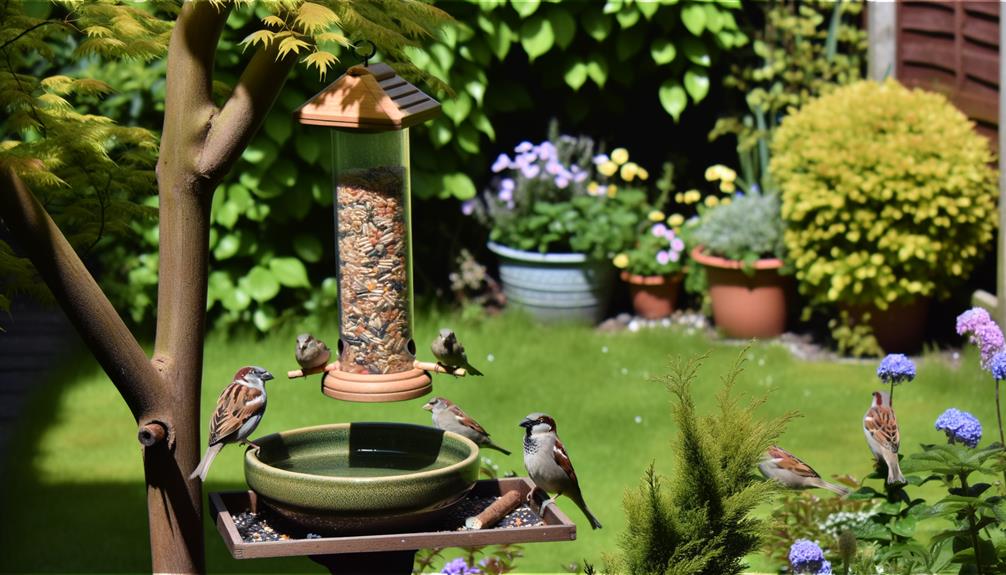
Key Takeaways
- Offer a variety of seeds like millet, cracked corn, and sunflower seeds to meet their nutritional needs.
- Provide protein sources such as insects, mealworms, and boiled eggs, especially during breeding seasons.
- Avoid feeding sparrows harmful foods like bread, chocolate, avocado, onions, and garlic.
- Maintain clean feeding stations by regularly disinfecting with a bleach solution and replacing food daily.
- Adapt the diet seasonally by offering high-energy foods in winter and protein-rich foods in summer.
Understanding House Sparrow Diet
To effectively feed a house sparrow, it is important to understand its omnivorous diet, which primarily consists of grains, seeds, and small insects. House sparrows (Passer domesticus) exhibit dietary flexibility, allowing them to thrive in various environments.
During breeding seasons, they increase their intake of protein-rich insects to support nestling growth. Conversely, in colder months, grains and seeds form the bulk of their diet, providing essential calories.
Additionally, house sparrows occasionally consume fruits and vegetables, which contribute essential vitamins and minerals. Recognizing these dietary preferences is pivotal for anyone aiming to provide an optimal feeding regimen.
Best Seeds for Sparrows
Selecting the most suitable seeds for house sparrows involves understanding their nutritional needs and preferences, which include a variety of grains such as millet, cracked corn, and sunflower seeds.
Millet is particularly favored due to its small size and ease of consumption. Cracked corn provides essential carbohydrates, while sunflower seeds offer high protein and fat content, critical for energy and overall health.
It is advisable to use black oil sunflower seeds, as their thinner shells facilitate easier feeding. Additionally, sparrows benefit from white proso millet, which is rich in protein and amino acids.
Combining these seeds in a balanced mixture ensures sparrows receive a complete diet, promoting energy and well-being. Proper seed selection is essential for maintaining healthy house sparrow populations.
Fruits and Vegetables
In addition to seeds, incorporating a variety of fruits and vegetables in the diet of house sparrows can provide essential vitamins, minerals, and hydration that seeds alone may not offer. These food items can enhance the overall health and energy of the birds.
When selecting fruits and vegetables, consider the following:
- Freshness: Make sure all produce is fresh and free from pesticides.
- Variety: Offer a range of items such as apples, berries, carrots, and leafy greens to ensure a balanced intake of nutrients.
- Preparation: Cut fruits and vegetables into small, manageable pieces to facilitate easier consumption.
- Frequency: Introduce these items gradually and observe the sparrows' preferences and reactions.
This approach supports a well-rounded diet that promotes optimal health.
Protein Sources
Incorporating protein sources such as insects, mealworms, and boiled eggs into the diet of house sparrows is necessary for their growth, muscle development, and overall health. Insects provide a natural and easily digestible source of protein and are rich in essential amino acids.
Mealworms, both live and dried, are particularly beneficial due to their high protein content and ease of consumption. Boiled eggs, especially the yolk, offer a concentrated source of protein and important nutrients.
These protein sources should be offered in moderation, maintaining a balanced diet. Ensuring variety in protein intake is essential to mimicking the sparrow's natural foraging habits, thereby promoting best physiological and developmental outcomes.
Avoiding Harmful Foods
While providing nutritious foods is crucial for the health of house sparrows, it is equally important to recognize and avoid feeding them harmful substances that could endanger their well-being.
Certain foods pose risks due to their toxicity or indigestibility. Key items to avoid include:
- Bread – Offers little nutritional value and can lead to digestive issues.
- Chocolate – Contains theobromine, which is harmful to birds.
- Avocado – Persin, a substance found in avocados, is detrimental to sparrows.
- Onions and Garlic – These can trigger hemolytic anemia and gastrointestinal distress.
Understanding these dietary dangers guarantees the safety and longevity of house sparrows, promoting a healthier avian community.
Choosing the Right Feeder
Selecting an appropriate feeder is important for guaranteeing that house sparrows have access to the right type of food in a way that minimizes waste and prevents the attraction of pests.
Tube feeders with small perches are particularly effective, as they allow sparrows to feed comfortably while discouraging larger, non-target species. Additionally, feeders with adjustable ports can control the flow of seed, reducing spillage and limiting access for pests.
Mesh feeders are another suitable option, providing adequate support for sparrows to cling to while feeding. It is also vital to select feeders made from durable, weather-resistant materials to ensure longevity and ease of cleaning.
This careful selection fosters a hygienic feeding environment conducive to the health of house sparrows.
Placement of Feeders
Proper placement of feeders is crucial for ensuring that house sparrows have safe and consistent access to food.
The best feeder height should be between 5 to 6 feet above the ground to deter predators.
Additionally, positioning feeders in sheltered locations can mitigate the effects of adverse weather conditions and provide a secure feeding environment.
Optimal Feeder Height
Determining the best feeder height is crucial for guaranteeing house sparrows can access food safely while minimizing the risk of predation and competition from other bird species.
The ideal feeder height involves several specific considerations:
- Predation Risk: Position feeders at a height of 5-6 feet to prevent ground predators like cats from reaching them.
- Visibility: Guarantee feeders are visible but not isolated, allowing sparrows to spot predators while maintaining some cover.
- Accessibility: Place feeders at a convenient height for refilling, typically between chest and eye level for most adults.
- Competition: Elevate feeders to deter larger birds and mammals that might outcompete house sparrows for food, guaranteeing adequate feeding opportunities.
Implementing these guidelines fosters a safe and efficient feeding environment for house sparrows.
Ideal Locations
Identifying the best spots for placing feeders is vital to make certain house sparrows have easy access to food while minimizing threats and maximizing their comfort.
Ideal locations include areas with natural cover such as shrubs or trees, offering sparrows a quick retreat from predators. Place feeders at least 5-10 feet away from dense foliage to prevent ambushes by cats.
Situate feeders in quiet, low-traffic zones to reduce disturbance. Positioning feeders at varying heights and distances will accommodate different sparrow behaviors and preferences.
Additionally, avoid situating feeders too close to windows to prevent collision risks. By carefully selecting feeder locations, one can create an environment conducive to the safety and well-being of house sparrows.
Weather Considerations
Assessing weather conditions is crucial in determining the best placement of feeders to guarantee house sparrows have consistent access to food throughout changing seasons. Proper placement guarantees feeders are protected from harsh elements and provide a stable food source.
Consider the following:
- Wind Protection: Position feeders in sheltered areas to prevent spillage and make sure sparrows can feed comfortably without disturbance.
- Sun Exposure: Place feeders where they receive morning sunlight, assisting in melting frost and making food more accessible during colder months.
- Rain Cover: Utilize weatherproof feeders or position them under eaves or tree branches to keep food dry and prevent spoilage.
- Snow Clearance: In snowy regions, place feeders at a height that remains accessible above snow accumulation, ensuring continuous access.
These practices optimize feeder placement for weather resilience.
Maintaining Cleanliness
Proper hygiene practices are essential to minimize the risk of disease transmission among house sparrows and maintain their overall health.
Regularly clean feeding stations with a solution of one part bleach to nine parts water, ensuring thorough rinsing to remove any chemical residue.
Replace food daily to prevent mold and bacterial growth, which can lead to infections.
Additionally, remove any uneaten food and fecal matter from the surrounding areas to deter pests and pathogens.
Utilize feeders made of materials such as metal or plastic, which are easier to disinfect than wood.
Seasonal Feeding Tips
Seasonal variations greatly influence the dietary requirements and feeding behaviors of house sparrows.
During winter, these birds require high-energy foods such as sunflower seeds and suet to maintain body heat and energy levels.
Conversely, in summer, a diet rich in insects and fruits supports their breeding activities and provides necessary hydration.
Winter Nutritional Needs
During the winter months, house sparrows need a diet rich in high-energy foods to maintain their body heat and overall health. Fat-rich seeds and grains are necessary to meet their caloric needs.
To guarantee optimal nutrition, consider the following:
- Sunflower Seeds: High in fat and protein, providing essential energy.
- Millet: Rich in carbohydrates, aiding in quick energy release.
- Cracked Corn: Offers a good mix of fats and carbohydrates.
- Peanut Pieces: High in fats and proteins, essential for maintaining body heat.
Additionally, providing fresh water is essential, as hydration supports metabolic processes.
These dietary components help house sparrows endure the harsh conditions of winter, ensuring they remain robust and healthy.
Summer Feeding Strategies
As temperatures rise and food availability increases, house sparrows shift their dietary needs to include a greater variety of protein-rich insects and nutrient-dense seeds.
Summer is a crucial period for these birds as they require additional protein to support molting and breeding activities.
Best feeding strategies should focus on providing a mixture of mealworms, aphids, and other small insects, which cater to their heightened protein requirements.
Additionally, offering seeds such as millet and sunflower seeds ensures a balanced diet.
Making sure fresh water availability is equally important, as hydration supports their physiological functions.
Monitoring Sparrow Health
Maintaining a watchful observation of your house sparrow's behavior, plumage condition, and feeding habits is crucial for early detection of potential health issues. Regular monitoring allows for timely interventions and enhances the bird's well-being. Key aspects to observe include:
- Behavioral Changes:
Look for signs of lethargy, abnormal aggression, or unusual tameness.
- Plumage Condition:
Healthy feathers should be smooth and glossy; watch for any signs of feather loss, dullness, or irregular molting.
- Feeding Habits:
Notice any decrease in appetite, changes in food preferences, or difficulty in eating.
- Physical Symptoms:
Check for visible signs such as swelling, discharge from eyes or nostrils, and abnormal droppings.
Consistent observation and prompt action can greatly improve a house sparrow's health and longevity.
Conclusion
Feeding house sparrows requires a detailed understanding of their dietary needs, including the best seeds, fruits, vegetables, and protein sources while avoiding harmful foods. Proper placement of feeders and maintaining cleanliness are essential to their health.
Seasonal adjustments and monitoring sparrow health guarantee their well-being. Essentially, providing for these birds is not a hasty operation; it demands consistent attention and informed care to support their thriving presence in human environments.


